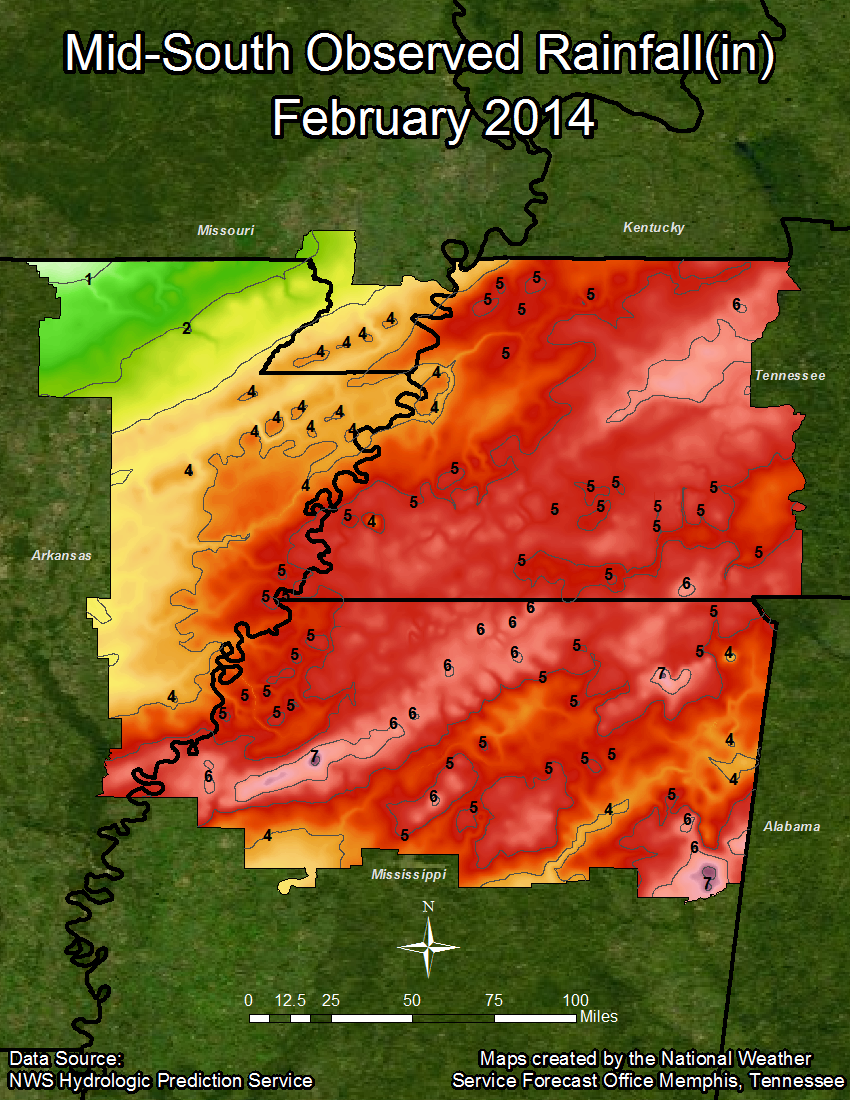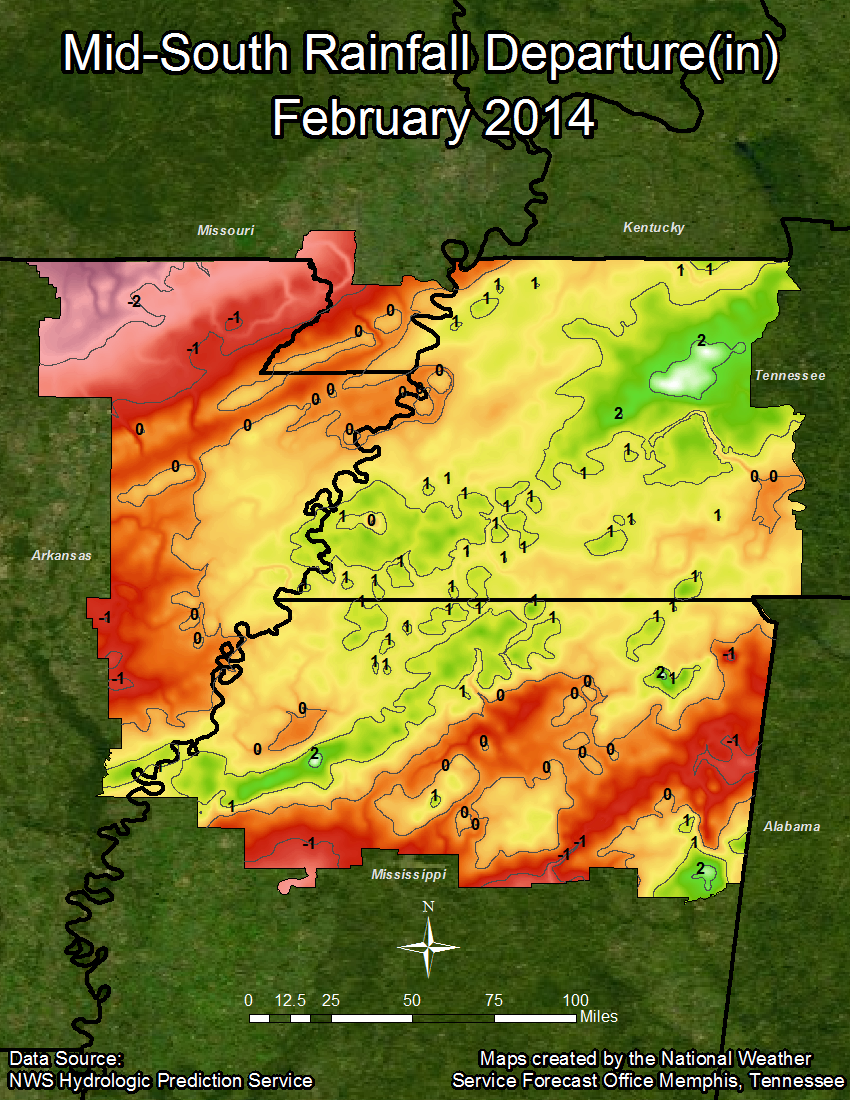...FEBRUARY 2014 MONTHLY CLIMATE SUMMARY...
February was both cooler and drier than normal across the Mid-South.
Tupelo was the warmest site of the official reporting sites with an average temperature of 42.5 degrees, which was still 3.4 degrees below its February normal average temperature of 45.9 degrees. Memphis was the second warmest with an average temperature of 41.1 degrees, a 4.4 degree departure below the normal of 45.5 degrees. Jackson had an average temperature of 38.2 degrees, a 4.1 degree departure below the normal of 42.3 degrees. Jonesboro had the greatest departure from normal with its average temperature of only 33.3 degrees, the coolest of the official sites, 8.2 degrees below the February normal of 41.5 degrees. All four official sites are also below normal for 2014 so far, with both Memphis and Jonesboro at 4.8 degrees below their normal average temperatures, and Jackson and Tupelo both 4.9 degrees below their normal average temperatures. Jonesboro has the coolest average temperature so far for the year at only 34.7 degrees, while Tupelo has the warmest average temperature for 2014 so far at 38.9 degrees. Despite average temperatures for the month being so cool, all official sites did manage to reach at least 70 during the month, while 14 degrees was the lowest temperature recorded at any of the sites.
Jonesboro was the driest official site during the month of February with a total of 2.59 inches of precipitation. As a result, Jonesboro also had the greatest departure from normal at 1.13 inches below the precipitation normal of 3.72 inches. Although the driest, Jonesboro received the most snowfall during February with 1.0 inch. The greatest snow depth in Jonesboro was also 1 inch. Tupelo received 4.33 inches of precipitation, a 0.63 inch departure below the normal of 4.96 inches. Tupelo received 0.5 inches of snowfall in February and the greatest snow depth there was 1 inch. Memphis measured 4.96 inches of precipitation, 0.57 inches above the normal of 4.39 inches for the month. Memphis received the smallest amount of snowfall with only 0.3 inches, and a greatest snow depth of only a trace. Jackson was the wettest official site with 5.15 inches, finishing the month 0.98 inches above the normal of 4.17 inches. Jackson received 0.5 inches of snowfall in February, and had a greatest snow depth of 1 inch. In addition to being the wettest site for the month of February, Jackson is also the wettest site for the year so far with 8.16 inches of precipitation, which is 0.08 inches below normal for this point in the calendar year. All official sites currently have below normal precipitation totals for the year so far, but Jackson has the smallest departure from normal. Tupelo has the greatest departure from normal, having received only 6.10 inches of precipitation so far in 2014. This is 3.34 inches below the normal of 9.44 inches of precipitation in Tupelo at this point in the year. Below are the data for the month of February and the first two months of 2014 as a whole.
TEMPERATURE DATA:
Memphis Jackson Jonesboro Tupelo
Average Temperature (MONTH) : 41.1 38.2 33.3 42.5
Normal Avg. Temp (MONTH) : 45.5 42.3 41.5 45.9
Departure from Normal (MONTH): -4.4 -4.1 -8.2 -3.4
Average Temperature (YEAR) : 38.6 35.4 34.7 38.9
Normal Avg. Temp (YEAR) : 43.4 40.3 39.5 43.8
Departure from Normal (YEAR) : -4.8 -4.9 -4.8 -4.9
Maximum Temperature : 74.0 74.0 71.0 77.0
Minimum Temperature : 19.0 14.0 14.0 19.0
PRECIPITATION DATA:
Memphis Jackson Jonesboro Tupelo
Total Precipitation (MONTH) : 4.96 5.15 2.59 4.33
Normal Precipitation (MONTH) : 4.39 4.17 3.72 4.96
Departure from Normal (MONTH): 0.57 0.98 -1.13 -0.63
Total Precipitation (YEAR) : 8.12 8.16 4.71 6.10
Normal Precipitation (YEAR) : 8.37 8.24 7.15 9.44
Departure from Normal (YEAR) : -0.25 -0.08 -2.44 -3.34
SNOWFALL DATA:
Memphis Jackson Jonesboro Tupelo
Total Snowfall (MONTH) : 0.3 0.5 1.0 0.5
Normal Snowfall (MONTH) : 1.3 1.6 1.3 0.6
Departure from Normal (MONTH): -1.0 -1.1 -0.3 -0.1
Greatest Snow Depth (MONTH) : Trace 1 1 1
Winter 2014 Review:
The end of February also marked the end of meteorological winter, which encompasses the months of December, January, and February. All four official sites experienced cooler than normal temperatures, below normal precipitation totals, and below normal snowfall for winter 2014. Tupelo was the warmest site this winter with an average temperature of 40.3 degrees, which is 3.6 degrees below the normal winter average temperature of 43.9 degrees. Memphis had an average temperature of 39.9 degrees this winter, a 3.5 degree departure below the normal of 43.4 degrees. Jackson had a winter average temperature of 37.0 degrees, a 3.4 degree departure below the 40.4 degree normal. Jonesboro was the coolest official site this winter with an average temperature of 35.0 degrees, 4.5 degrees below the normal of 39.5 degrees. This also made Jonesboro the official site with the greatest departure from normal in terms of average temperature.
In addition to being the coolest official site this winter, Jonesboro was also the driest site, with a precipitation total of 11.15 inches, a 0.77 degree departure from the normal of 11.92 inches. Although Jonesboro was the driest site this winter, Tupelo actually had the greatest departure from normal with its precipitation total of 12.28 inches, a 3.44 degree departure below the normal of 15.72 inches. Jackson was the wettest site this winter with 12.96 inches of precipitation, beating out Memphis by only 0.02 inches. Jonesboro received the most snowfall of the official sites this winter with 2.0 inches, a 2.1 inch departure from the normal of 4.1 inches. Memphis received the least amount of snowfall with only 0.3 inches, a 1.6 degree departure from the winter normal of 1.9 inches. Below are the data for the meteorological winter of 2014.
TEMPERATURE DATA:
Memphis Jackson Jonesboro Tupelo
Average Temperature (Winter14) : 39.9 37.0 35.0 40.3
Normal Avg. Temp (Winter) : 43.4 40.4 39.5 43.9
Departure from Normal (Winter14): -3.5 -3.4 -4.5 -3.6
PRECIPITATION DATA:
Memphis Jackson Jonesboro Tupelo
Total Precipitation (Winter14) : 12.94 12.96 11.15 12.28
Normal Precipitation (Winter) : 14.11 13.59 11.92 15.72
Departure from Normal (Winter14): -1.17 -0.63 -0.77 -3.44
SNOWFALL DATA:
Memphis Jackson Jonesboro Tupelo
Total Snowfall (Winter14) : 0.3 0.5 2.0 0.5
Normal Snowfall (Winter) : 1.9 4.1 4.1 1.8
Departure from Normal (Winter14):-1.6 -3.6 -2.1 -1.3
Climate Outlook:
For the month of March, the Climate Prediction Center (CPC) has predicted below normal temperatures for the northern tier of our forecast area, while an equal chance for above normal, normal, or below normal temperatures for the southern tier. The CPC has also predicted an equal chance of above normal, normal, or below normal precipitation totals for the entire forecast area for the month of March. Normal high temperatures for March range from the upper 50s to upper 60s across the Mid-South, with normal low temperatures ranging from the mid 30s to the upper 40s. Normal precipitation values for March range from 4.0 to 5.5 inches among the four official sites.
The CPC has issued an El Niño Watch, with a 50% chance of El Niño developing during the summer or fall. Currently we are in an ENSO-neutral (ENSO stands for El Niño Southern Oscillation) phase, which means we are neither in El Niño or La Niña. Sea-surface temperatures (SSTs) are the best predictor of ENSO phase, and forecasts indicate SSTs warming across the equatorial Pacific, a sign that El Niño may develop. ENSO plays a large role in our climate across the Mid-South, so it can be a good predictor of what we can expect in future seasons. We will continue to monitor the ENSO phase in future months’ climate summaries.


MAYE